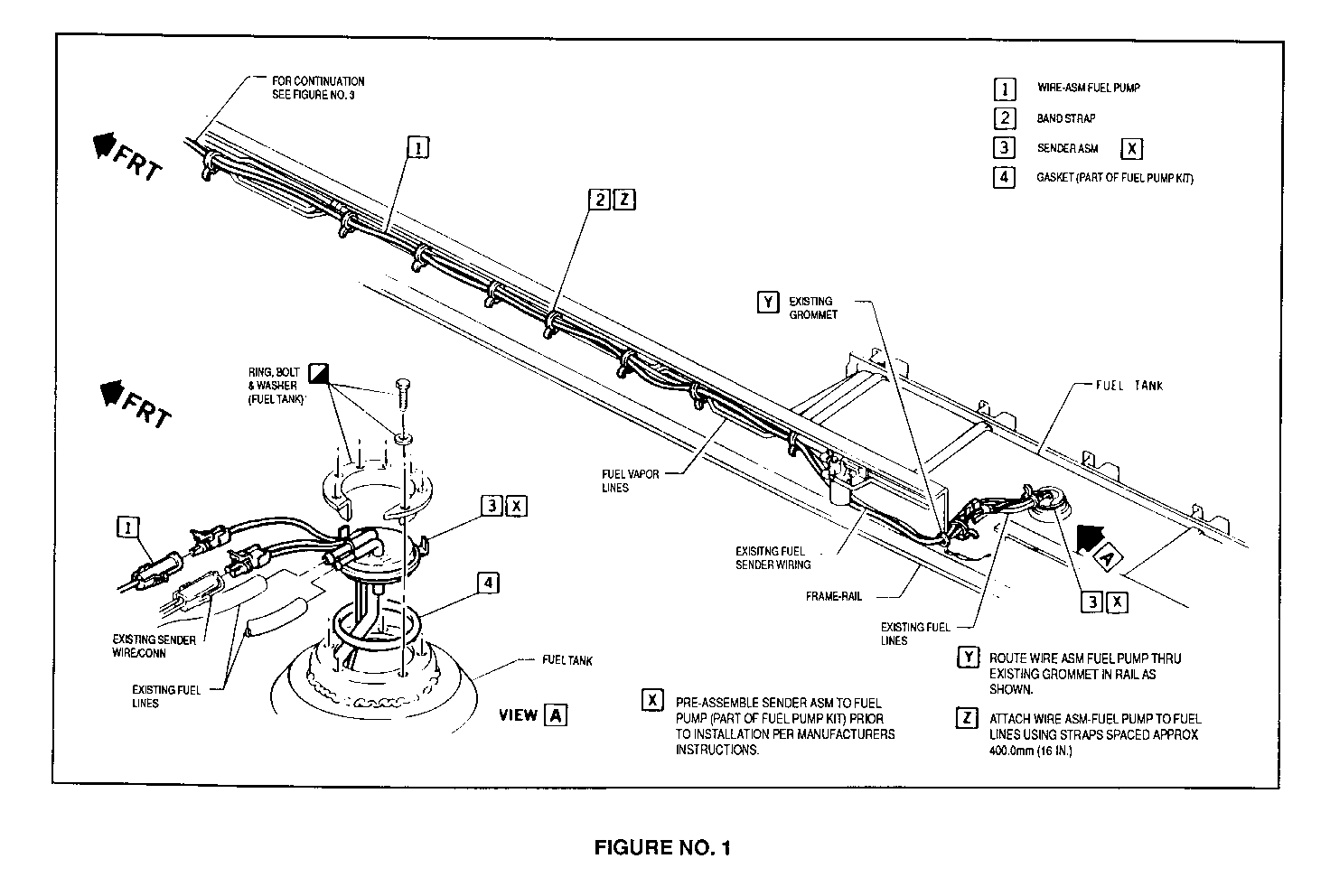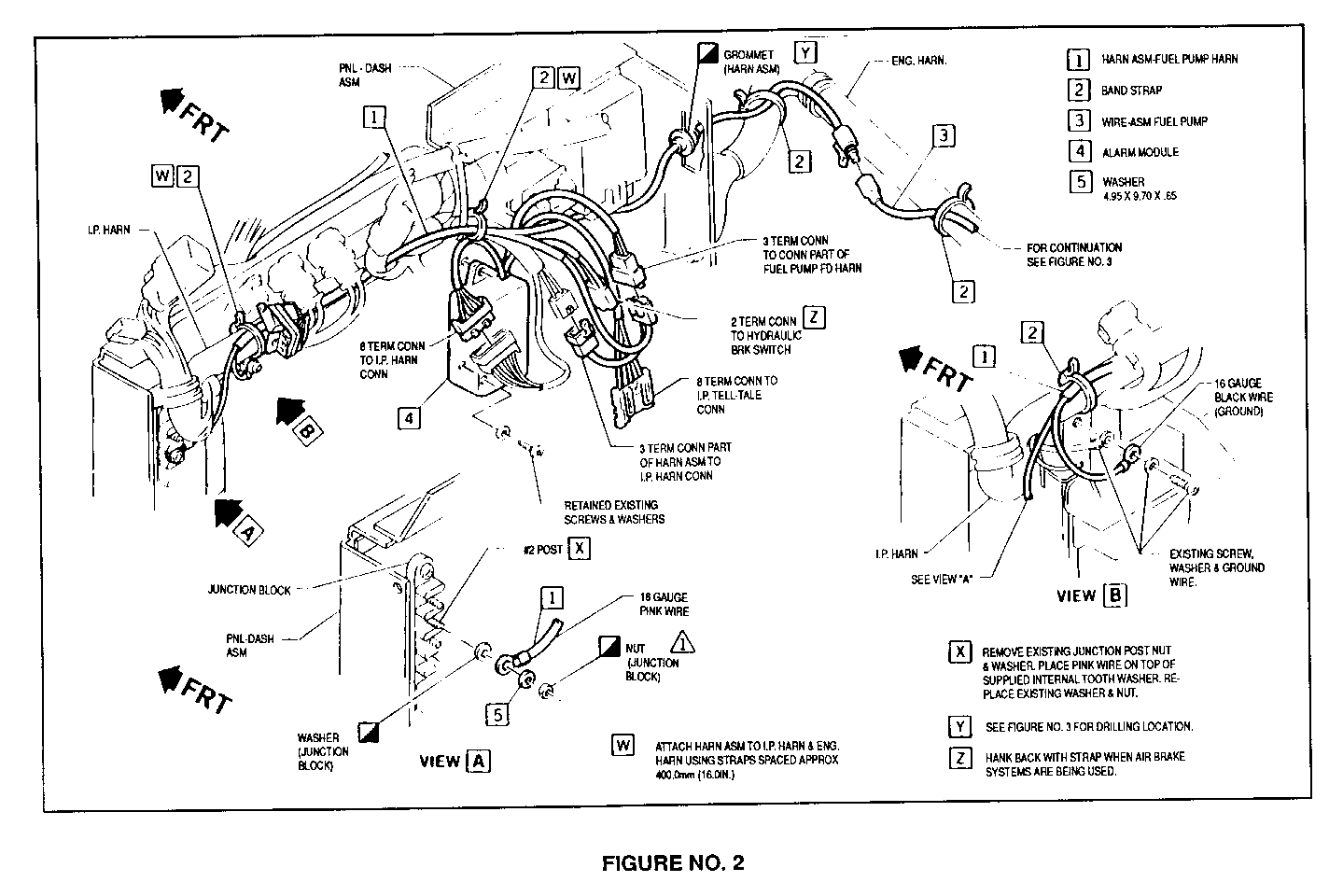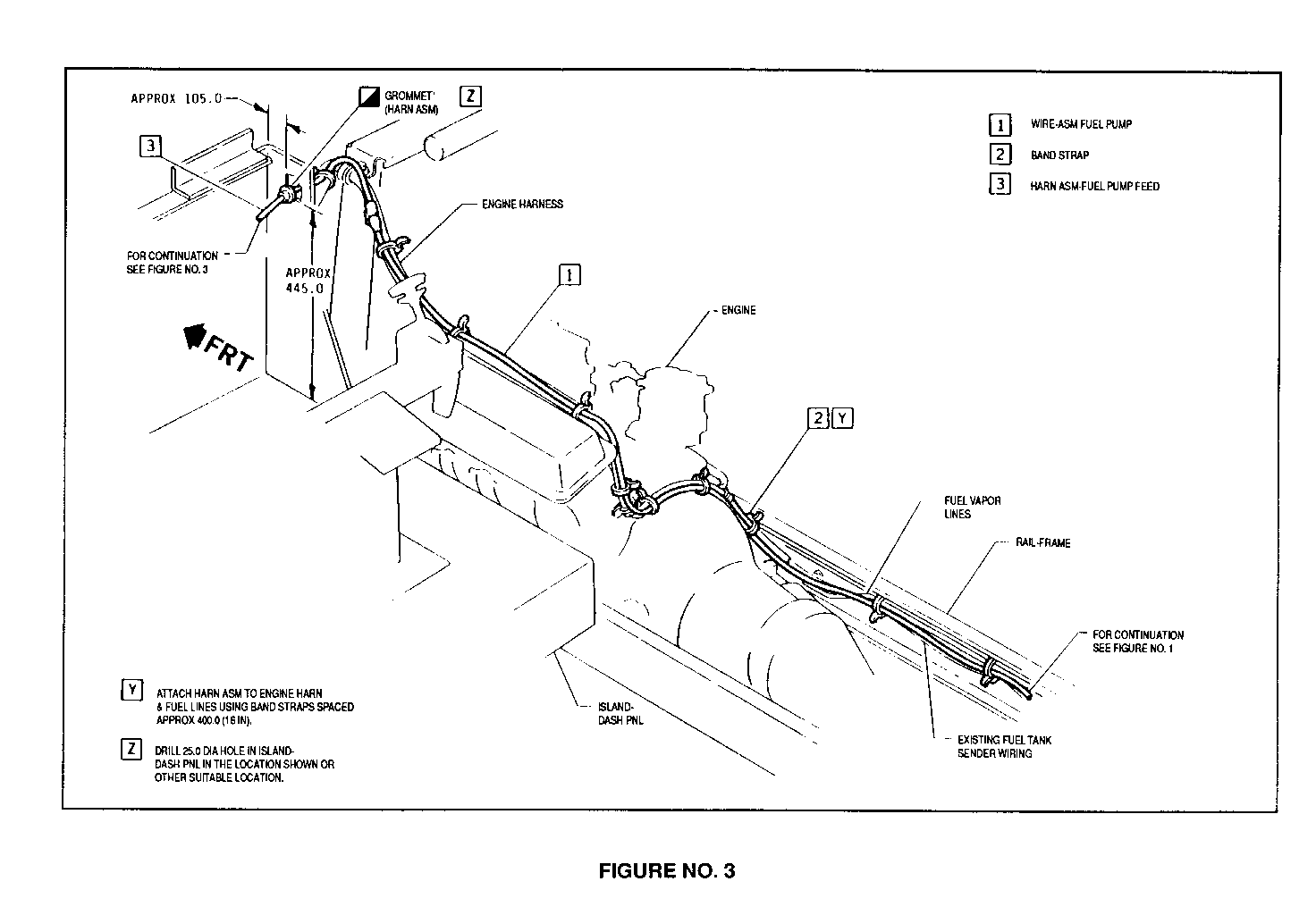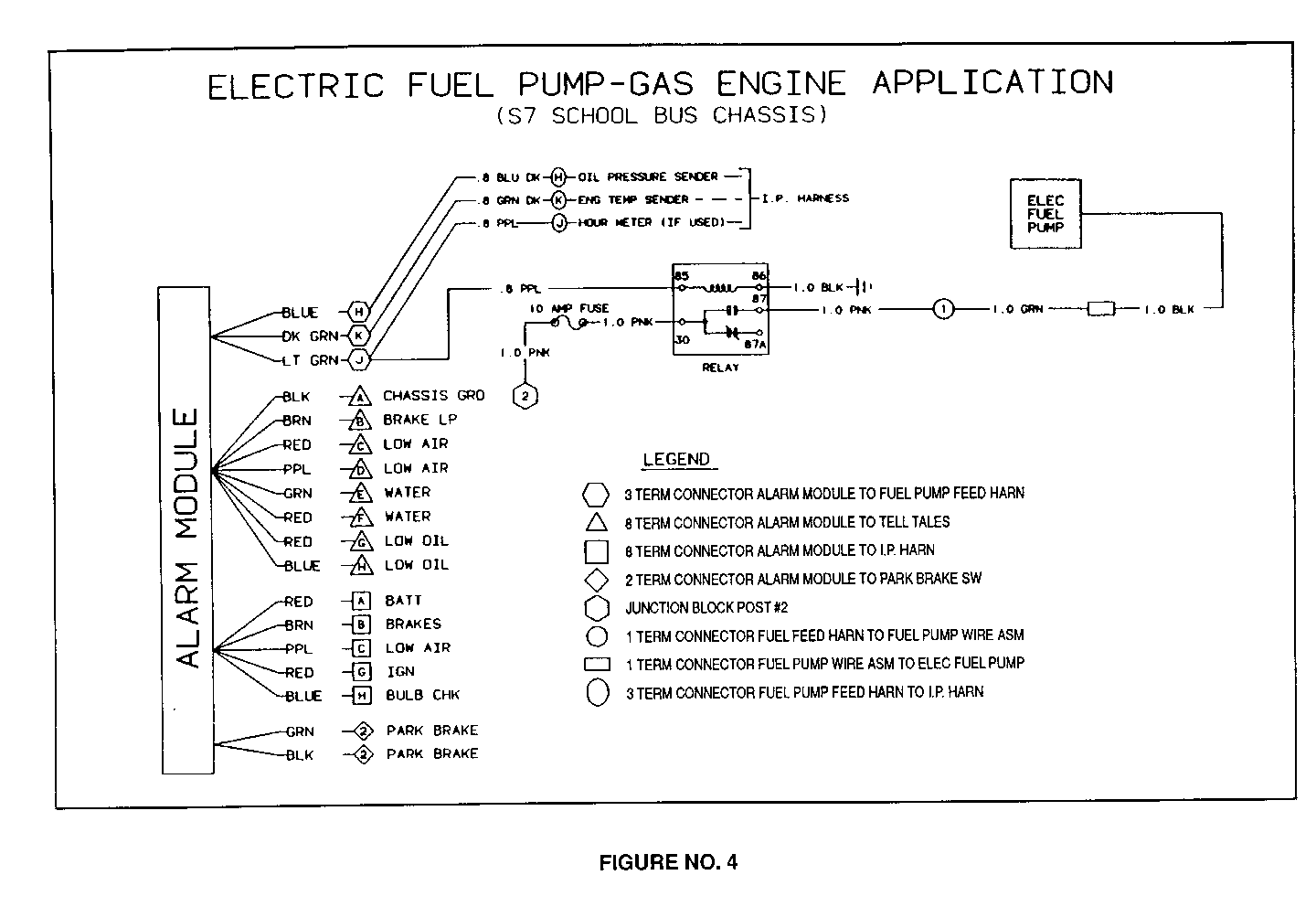LOSS OF PWR. DUE TO VAPOR LOCK (INSTALL NEW VAPOR LOCK KIT)

SUBJECT: LOSS OF POWER DUE TO VAPOR LOCK
MODELS: 1987-88 MEDIUM DUTY S7T042 EQUIPPED W/6.0L GAS ENGINE (VIN B) AND 60 GALLON FUEL TANK
Some 1987-88 subject model vehicles may experience an intermittent loss of engine power due to fuel line vapor lock when operated during high ambient temperatures and/or heavy load conditions.
Listed below are some of the conditions experienced when vapor lock occurs:
1. Loss of engine power when hot, but operates properly after sitting several hours or overnight.
2. Engine will not continue to run when hot.
3. Long starter crank times when attempting to start a hot engine.
Vapor lock occurs when fuel in the line vaporizes. Because the engine mechanical fuel pump is actually a liquid suction pump, when this condition occurs the fuel pump efficiency may be greatly reduced or the pump may become inoperative. One way to eliminate the effects of vapor lock is to push the fuel to the engine mechanical fuel pump with an electric PUMP.
Service has released an in-tank electric fuel pump kit which incorporates an electric pump, fuel gage sender, wiring harness and an electric pump/control module. This will improve the performance of the engine when operated in high ambient temperatures or under heavy load conditions.
IMPORTANT: This change win provide an engine alarm system on vehicles not previously equipped with (54) alarm system.
To eliminate the vapor lock condition, the service procedure will require the ordering and installation of three (3) separate part numbers which are deter- mined by the vehicle RPO content. These three (3) separate parts are listed below:
1. Fuel Tank Sender Assembly
2. Electric Pump Assembly
3. Vapor Lock Installation Kit
Adequate care must be used when ordering parts to make this change to insure proper installation and results. See parts list contained in this bulletin.
SERVICE PROCEDURE
1. IN-TANK FUEL PUMP INSTALLATION ------------------------------
Listed below are three separate service procedures which can be used to remove/install electric in-tank fuel pumps, depending on the bus body, fuel tank capacity, and wheel base.
CAUTION:
To help prevent a fire and personal in- jury when working on the fuel system, disconnect the vehicle battery ground (-) cable(s) and be sure fire fighting and safety equipment as required by any fire and safety regulations and dealership policies are available.
A. In-tank pump installation on vehicles equipped with a body access hole:
1. Remove four screws and access plate (plate may be secured to the floor with sealer and may have to be pried loose).
2. Disconnect fuel sender wire and fuel lines.
3. Remove seven mounting screws, washers and mounting ring from sender and retain.
4. Remove sender and gasket from tank and discard.
5. Clean gasket mounting area thoroughly and install new gasket (4) (Figure No. 1).
6. Follow instructions supplied for assembly of fuel pump to sending unit and then install sender/pump assembly. Reinstall mounting screws, washers and mounting ring (Figure No. 1).
7. Reconnect fuel lines and existing sender connector (Figure No. 1).
8. Route one end of fuel pump feed wire (1) from service kit through existing wiring grommet in frame and connect to sender/pump connector (3) (Figure No. 1).
9. Reinstall cover plate using sealer between plate and floor.
B. In-tank pump installation on vehicles equipped without a body access hole and the following options:
With 60 gallon fuel tank (LH9) and 187" (FWN) or 206" (FRT) or 226" (FQP) or 246" (ES3) wheel base.
1. Drain fuel from fuel tank.
2. Remove fuel line bracket and grommets in frame at fuel sender location (Figure No. 1).
3. Pull lines through frame until clamps are accessible. Remove clamps and disconnect hoses.
4. If sender wire cannot be reached for disconnection, cut sender wires at easily accessible point inside of frame channel.
5. Disconnect fuel tank vent valve from bracket at front of tank. This valve is secured with rose bud clips which must be compressed to slip valve out of bracket.
6. Remove outboard nuts securing the four tank mounting straps and pull studs out of mounting holes.
7. Totally remove the two inside straps from tank by removing cotter pins and clevis pins from inboard side.
8. Remove four cotter and clevis pins from horizontal mounting strut at rear of tank. Remove four nuts and bolts at inboard side of tank and remove strut.
9. Slide tank out of saddle brackets to rear of vehicle. To accomplish this, tank must be lifted up and tilted at outboard side so drain plug at bottom can clear saddle brackets and so vents on top of tank can clear the floor braces. Two technicians may be required for this step.
IMPORTANT: When tank is about half way out, the rear of the tank must be supported by a dolly jack to complete removal.
10. Remove seven mounting screws, washers and mounting ring from sender and retain.
11. Remove sender and gasket and discard. Save old connector and wires which were cut off at Step 4.
12. Clean gasket mounting area thoroughly and install new gasket (4).
13. Follow instructions supplied for assembly of fuel pump to sending unit and then install sender/pump assembly. Reinstall mounting screws, washers and mounting ring (Figure No. 1).
14. Connect existing sender connector to new sender/pump connector (3). Wires will be spliced when tank is reinstalled (Figure No. 1).
15. Route one end of fuel pump feed wire (1) from service kit through existing wiring grommet in frame and connect to sender/pump connector (Figure No. 1).
16. Slide fuel tank back into brackets at last two saddle brackets. Tank must be tilted up at outboard edge to dear gussets on brackets.
17. Reconnect fuel lines and install grommets.
18. If sender wires were cut, splice wires back together. Use staggered slice clips and double wrap securely with vinyl tape.
19. Center tank properly in brackets and reinstall tank rear horizontal strut.
20. Reinstall two inside tank mounting straps.
21. Reinstall nuts on tank mounting straps. Torque to 39-50 Nm (20-37 lbs/ft).
C. In-tank pump installation on vehicles equipped without a body access hole, and the following options:
With 60 gallon fuel tank (LH9) and 170" (EH8) wheelbase.
1. Drain fuel from fuel tank.
2. Remove fuel line bracket and grommet in frame at fuel sender location (Figure No. 1).
3. Pull lines through frame until clamps are accessible. Remove clamps and disconnect hoses.
4. Install a dolly jack and wooden blocks, if necessary, under fuel tank for support. It may be necessary to remove the two center skid plates from under the tank to properly balance the tank on the dolly.
5. Remove and retain the four (4) nuts, bolts and washers holding the fuel tank mounting brackets to the frame. Remove vent filter bracket with front mounting bracket.
6. Remove the four (4) clevis pins and cotter pins from outer ends of horizontal mounting struts on front and rear of tank.
7. Carefully lower tank sufficiently to gain access to fuel sender unit.
8. Disconnect fuel sender unit wire at tank unit.
9. Slide fuel tank outboard from frame if necessary for access to sender unit.
10. Remove seven mounting screws, washers and mounting ring from sender and retain.
11. Remove sender and gasket and discard.
12. Clean gasket mounting area thoroughly and install new gasket (4) (Figure No. 1).
13. Follow instructions supplied for assembly of fuel pump to sending unit and then install sender/pump assembly. Reinstall mounting screws, washers, and mounting ring (Figure No. 1).
14. Connect existing engine harness sender connector to new sender/pump connector (3).
15. Route one end of fuel pump feed wire (1) from service kit through existing wiring grommet in frame and connect to pump connector on sender/pump assembly (3) (Figure No. 1).
16. Jack up tank and mounting brackets to proper height for mounting.
17. Reconnect fuel lines, fuel line bracket or clip and reinstall grommets (Figure No. 1).
18. Reattach mounting brackets and horizontal struts to frame with existing hardware. Torque nuts to 61-68 Nm (45-50 lbs/ft).
2. ELECTRICAL MODULE ASSEMBLY AND FUEL PUMP WIRE ASSEMBLY ------------------------------------------------------
IMPORTANT: Figure No. 2 will assist in the assembly of the electrical module.
A. Unplug two (2) existing alarm module assembly connectors from instrument panel harness connectors. Also unplug park brake switch connector (hydraulic brakes only) at lever.
B. Remove two (2) screws holding alarm module to control island dash panel. Discard alarm module and retain screws and washers.
C. Drill a 25.0 mm hole in control island dash panel and insert engine compartment and seat feed harness grommet (Figure No. 3).
IMPORTANT: All holes drilled in control is- land must be clear of all components and reinforcement panels.
D. Install new alarm module (4) from service kit with existing screws and washers (Figure No.
E. Connect fuel pump feed harness connectors (1) as follows (Figure No. 2):
1. Module connector (3-way female) to module assembly (4).
2. Instrument panel connector (3-way male) to instrument panel harness.
IMPORTANT: Connector may be taped back to body harness for vehicles equipped without engine alarm (x54).
F. Connect remaining module connectors (4) as follows (Figure No. 2):
1. Instrument panel connector (8-way female) to instrument panel harness.
2. Park brake connector (2-way male) to park brake switch jumper harness (hydraulic brakes only).
3. Tell-tale (8-way) connector to tell-tale.
4. Connect road speed governor (4-way).
G. Connect ground wire (16-gauge black) ring terminal to existing ground screw. Torque to 3.4-4.6 Nm (30-40 lbs/in) View (B) (Figure No. 2).
H. Connect 16 gauge pink wire ring terminal to #2 junction block post. Apply terminal on top of existing lock washer, add lock washer from service kit on top of ring terminal and replace junction post nut. Torque to 1.4-2.0 Nm (12-18 lbs/in), View (A) (Figure No. 2).
I. Re-wrap fuel pump feed harness (1) to instrument panel harness and tie back excess wire. Tie-wrap alarm module wiring (4) to instrument panel wiring in two places (Figure No. 2).
J. Route fuel pump wire assembly (1) from fuel tank to control island area with the engine harness (Figures No. 1 and 3).
K. Attach fuel pump wire assembly to existing harness with the 20 band straps (2) provided in the service kit. Space straps approximately 400 mm (16 inches) apart. If there is excess length in wire assembly, tie back excess and band strap to body of existing harness (Figures No. 2 and 3).
Attach connector on fuel pump wire assembly (1) to fuel pump harness connector (3) at control island area (Figure No. 2).
3. FINAL INSPECTION AND TEST ----------------------------
A. Reconnect battery ground cable.
B. Reinstall tank drain plug.
C. Refill tank with fuel and operate pump.
IMPORTANT: To check if in-tank fuel pump is operating properly, it will be necessary to disconnect fuel line at tank and check for flow, since mechanical pump is still operational.
D. Check fuel lines and drain plug for leaks.
PARTS INFORMATION
To make above changes, three (3) parts must be ordered as listed below:
* Fuel Tank Sender Assembly
* Electric Pump Assembly
* Vapor Lock Installation Kit/Electrical Harness
PART NUMBER DESCRIPTION QUANTITY ----------- ----------- -------- 15625335 Installation kit used with 1 60 gallon fuel tank
25094477 Sender Assembly 60 gallon 1
25115955 Electric Fuel Pump 1
Parts are currently available from GMSPO.
For repairs performed under warranty, use the applicable labor operations listed below:
* For vehicles equipped with sending unit access hole in body: T7635, 2.2 hrs
* For vehicles not equipped with sending unit access hole in body: T7630, 4.7 hrs




General Motors bulletins are intended for use by professional technicians, not a "do-it-yourselfer". They are written to inform those technicians of conditions that may occur on some vehicles, or to provide information that could assist in the proper service of a vehicle. Properly trained technicians have the equipment, tools, safety instructions and know-how to do a job properly and safely. If a condition is described, do not assume that the bulletin applies to your vehicle, or that your vehicle will have that condition. See a General Motors dealer servicing your brand of General Motors vehicle for information on whether your vehicle may benefit from the information.
